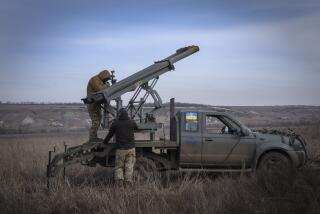U.S. Will Pull Its Last 1,500 GIs Out of Iraq
WASHINGTON — The Bush Administration is expected to announce today the withdrawal of the last 1,500 U.S. troops in Iraq as it turns over protection of Iraq’s minority Kurdish population to an eight-nation mobile strike force deployed in neighboring Turkey.
The pullout, expected to begin this weekend and to be completed by July 20, will effectively end Operation Provide Comfort, the Kurdish protective mission, and represents a milestone in the 11-month U.S. intervention in the Persian Gulf.
The withdrawal will allow the Administration to meet its self-imposed deadline for getting American troops out of northern Iraq while providing an alternative protective force to look after the embattled Kurds, U.S. officials said.
At the same time, it will give Iraqi President Saddam Hussein control of his entire country for the first time since the Gulf War began in January. The only foreign forces will be 500 lightly armed U.N. guards who will monitor security for the Kurds in northern Iraq.
A ranking U.S. official said the Administration intends to “stand firm” against Hussein and any attempted reprisals by his government against the nearly 4 million Kurds, who represent about one-fifth of Iraq’s population.
The new mobile strike force in Turkey will total 2,500 to 3,000 troops drawn from the eight contributing nations--the United States, Britain, France, Italy, Turkey, Belgium, Spain and the Netherlands, U.S. officials said. American troops will constitute at least half of the force and will assume command and control responsibilities. The other contingents were described as “token” forces.
“We obviously believe it will be sufficient,” a senior Pentagon official said of the mobile strike force. The number of combat troops in the force will be approximately the same as the combat troops stationed inside Iraq during Operation Provide Comfort, he said.
The U.S. withdrawal is not without risk, some analysts noted, and Hussein’s ability to keep power to this point represents a major political accomplishment.
“The pullout will be another step in Saddam’s continued political recovery after the end of the war,” said Peter Galbraith, a Senate Foreign Relations Committee staff member who toured northern Iraq during the Kurdish uprising this spring. “It will give him more latitude to do what he wants at home.”
At the height of Operation Provide Comfort, 11,900 U.S. troops and 9,000 personnel from 11 other countries--including combat and support troops--were deployed to assist and protect more than 2.5 million Kurds who fled to Turkey, Iran and border regions within Iraq, according to U.S. and U.N. figures.
After the withdrawal, about 44,000 U.S. troops will still be deployed in Saudi Arabia, Kuwait and on ships in the Persian Gulf. The target date for withdrawing the last U.S. ground forces is September, although a substantial U.S. armada, including an aircraft carrier, is expected to remain indefinitely in or near the Gulf.
The strike force of up to 3,000 troops will include a “reinforced battalion” of some 1,000 to 1,200 ground troops, stationed at Silopi, Turkey, near the Iraqi border, officials said.
An air-support contingent, provided largely by the United States, will be based at Incirlik Air Base in Turkey, with helicopters and attack aircraft. The United States also maintains several squadrons of attack aircraft, including A-10s and F-16s, at Incirlik as part of its NATO commitment.
The strike force will receive naval support from the the carrier task force near the Persian Gulf and a second carrier task force in the eastern Mediterranean, a Pentagon official said.
The force initially will consist of U.S. troops withdrawn from Iraq. Those personnel eventually will be replaced by American forces rotated from the European command.
Besides satisfying the Administration’s withdrawal timetable, the pullout will prevent the possibility of a protracted deployment that might enmesh U.S. troops in local politics, as happened when U.S. Marines were stationed in Beirut from 1982 to 1984.
Foreign-policy analysts, however, questioned the timing of the withdrawal. “The amount of unfinished business is enormous,” said William Quandt, a Mideast specialist at the Brookings Institution and a former National Security Council staffer.
“Saddam does take military pressure seriously. If you want to influence his behavior, removing troops down to a residual force in Turkey sends a powerful signal that we’re willing to accept an outcome (to the Gulf War) as it stands today and an outcome that leaves him in power,” Quandt said.
Several observers said the pullout undermines the Kurdish negotiating position in talks with Baghdad on autonomy. Kurdish leaders Massoud Barzani and Jalal Talabani reportedly returned to the Iraqi capital Thursday to resume the discussions.
Some analysts predicted that Hussein eventually will launch a crackdown on the Kurds to retaliate for their March uprising.
“Saddam will not shell cities or blow buildings up. He will use secret police tactics--people will disappear; some will be murdered or kidnaped,” said Galbraith, the Senate Foreign Relations Committee staff member. “The over-the-horizon force will not be able to deal with this kind of problem. There will be no clear threshold for how the coalition will go back in. The pullout will leave the Kurdish people very exposed and in very serious danger.”
Added John Waterbury, a Mideast expert at Princeton University: “Saddam has proven himself to be more devious and manipulative than even his greatest detractors thought six months ago. He will do whatever he thinks he can get away with. . . . And he would like to reassert control in Kurdistan.”
More to Read
Sign up for Essential California
The most important California stories and recommendations in your inbox every morning.
You may occasionally receive promotional content from the Los Angeles Times.









